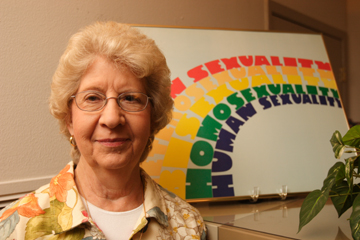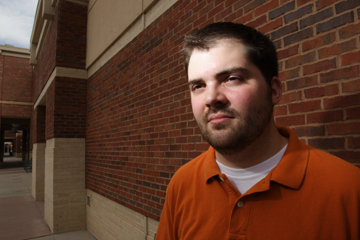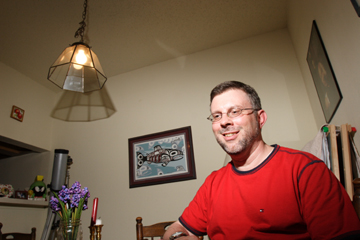Near the University of Texas at Arlington, in the shadow of a sprawling church, a small sanctuary occupies a suite in a towering office building.
 Living Hope Ministry looks like a model room from an IKEA catalog or perhaps an architect’s office, with bamboo floor mats, wicker baskets, and modern-looking track lights. Five years ago, in this office, Julie — who asked that her last name not be used — began the biggest change in her life, from practicing lesbian to … well, let her describe it. “It’s so much more complicated than ‘I was a lesbian, then I met God, and then I became straight.’ It’s a process,” she said. “When I first started doing the Jesus thing, I didn’t necessarily start out thinking I wasn’t going to be gay anymore. I just opened myself up to the possibility of a relationship with God.” In the end, she said, the ministry, which seeks to help people overcome their attraction to persons of the same sex, was “one of the most transformational things I’ve ever experienced.”
Living Hope Ministry looks like a model room from an IKEA catalog or perhaps an architect’s office, with bamboo floor mats, wicker baskets, and modern-looking track lights. Five years ago, in this office, Julie — who asked that her last name not be used — began the biggest change in her life, from practicing lesbian to … well, let her describe it. “It’s so much more complicated than ‘I was a lesbian, then I met God, and then I became straight.’ It’s a process,” she said. “When I first started doing the Jesus thing, I didn’t necessarily start out thinking I wasn’t going to be gay anymore. I just opened myself up to the possibility of a relationship with God.” In the end, she said, the ministry, which seeks to help people overcome their attraction to persons of the same sex, was “one of the most transformational things I’ve ever experienced.”
Former Dallas resident Mark Hufford was also looking for help with his sexual attraction to those of his own gender when he sought out an Arlington therapist more than a decade ago. Guilt drove him to it, he said — he was raised a Baptist and was in what seemed to others to be a standard heterosexual marriage. He now says he’s happier than he’s ever been — but that has come about in spite of rather than because of the counseling he received. He is openly gay now, and he’s leery of those who try to shame and cajole people into rejecting their sexuality. In fact, even though their stories start out the same way, Julie and Mark now represent the opposite sides in a strange and painful war being waged over the souls of lesbian, gay, bisexual, and transgendered people.
On one side are the religious groups that believe being gay is a sin and that homosexuals can choose — with help — to stop being gay. Ministries, camp counselors, and myriad therapists have dedicated their professional lives to helping them do that, and believe that theirs is a labor of love, not hate, in saving people trapped in a sinister gay lifestyle of precarious sex and recruitment of children. On the other side are gays, including many who have been through the “gay cure,” and secular therapists, who say the so-called conversion therapies are not only useless and without scientific basis but can actually cause deep and lasting trauma to people who may already be psychologically fragile. Such critics say that many of the testimonies of “ex-gays” trumpeted on the internet are either false or come from people who have eventually reverted to their old sexual habits. Skeptics say the movement is just another tool used by the Christian right to reinforce the idea of homosexuals as outcasts, and to justify the homophobic rhetoric has become an acceptable form of discourse in conservative circles.
Even within the gay-cure movement — or, as those within it refer to it, the “ex-gay” movement — however, some of the certainties seem to be slipping. Repeatedly in the last few years, anti-gay leaders have come stumbling out of the closet — including evangelical mega-church pastor Ted Haggard, who had served as spiritual advisor to President George W. Bush. Others are beginning to concede that “curing” homosexuality may not be possible — and that it is only behavior (gay sex and lifestyle) that they can reasonably hope to change, not the extinguishment of gay sexual urges. One prominent religious leader recently sparked a controversy by conceding that homosexuality might indeed be innate rather than a chosen behavior — although he also suggested that science might be able to produce a cure. And in the middle, still, are others like Julie and Mark, trying to find their way through a landscape marked by disputes over the science of sexuality, spirituality and identity, gay sheep (really), gay babies, sexual abuse, politics, and innumerable other elements that have caused this topic to garner more and more attention from the mainstream.
Though they agree on little else, both sides in this debate say that the so-called “reparative therapy” is a central factor in the battleground where religion, homosexuality, and politics come together. Rickety metal folding chairs are arranged in a semi-circle in a room inside the First Baptist Church of Arlington, where the “sufferers” meet for group therapy. Pastor Ricky Chelette, whose sleek black desk matches his black-rimmed glasses and jet-black hair, says that in an average week the ministry sees 40 to 50 people in person and gets almost 4,000 visitors seeking their help online. “We are a nonprofit ministry, a support group that helps people overcome their unwanted same-sex attraction,” he said. “We come from a very strong biblical perspective on what we understand DELETEure to teach about sexuality and homosexuality, and we help them align their life with those principles. These are people who come to us and want help. We’re not going to gay pride parades and pulling people out.” One such person is Julie, a 21-year-old Houston native who now lives in Arlington. After meeting Chelette and going through the program at Living Hope, she no longer identifies herself as a lesbian. “When I was in high school, I had decided that I was a lesbian,” she said. “My mom made me go see Ricky, I didn’t want to go.
Through Living Hope and meeting Ricky, I felt like I had the opportunity to be in a relationship with God, which has transformed my life.” Chelette said that his ministry does not provide therapy per se, but rather a system of support for people who are struggling with their sexuality to come together and share their experiences. “There is not any set formula for helping people overcome. It’s not a 12-step program. Everybody is an individual, and we treat them as individuals,” he said. “The support group helps to get at what we believe are some of the root issues that might cause them to have some of these feelings.” The first step at Living Hope is a one-on-one meeting with Chelette, in which he assesses whether or not a struggler is ready for group therapy. He also asks the individual to swear off acting out on their gay impulses and encourages healthy, non-sexual relationships with members of the same sex. Oftentimes, he said, a person’s sexuality is not addressed until other issues that get in the way — alcoholism, drug addiction, promiscuity — are dealt with.
If a person is deemed ready, he or she can begin to attend group sessions. Chelette refers those who aren’t to other therapists or continues one-on-one sessions with them until he deems them healthy enough to be around others dealing with same-sex attraction. Chelette’s approach is to help people create a personal relationship with God and to deal with the issues that he believes can cause a person to become gay. “Sexual abuse is one that we see repeatedly — much higher among women than men, but still very high among men,” he said. “Probably 45 to 50 percent of men deal with sexual abuse and as much as 80 percent in women.” Chelette believes that men and women usually turn to homosexuality for different reasons. “In men there is a real lack of affirmation, attention, and affection from their father, oftentimes in correlation with a very dominant, overbearing, emotionally overly connected mother,” he said. “We also see where young men have a significant amount of peer rejection, especially during their pre-adolescent and adolescent years, where they don’t seem to connect very well with other males.”
 The ministry attracts five times as many men as women. “We don’t see as many female strugglers as we do male strugglers,” Chelette said. “If there’s not sexual abuse, there is the absence of a father affirming them as women and celebrating them as women, or there is a father who is very much present but has made the girl his ‘little boy’ in terms of the way that he relates to her. She finds gratification, affirmation, and satisfaction from him by doing things that are traditionally thought of as masculine. For instance, she becomes the star athlete that he loves to be involved with. Usually there is a sense that the mother is weak and dominated by the dad. So the girl doesn’t want to identify with that kind of femininity, and she pulls away from her mom and really identifies with the dad.” The success rate at Living Hope is very high, the minister said, and those who stick with the program are typically able to overcome their homosexuality. However, his definitions of homosexuality and “overcoming” are generous. “We consider it a success if you’re living in obedience to the things that God says. Homosexuality is not God’s design or plan for man,” he said. “So for us, healing would come at the point of identifying yourself as a heterosexual who has had difficulty with being attracted to the same gender.” Which, to most people, would sound like people who are still gay but not having gay sex.
The ministry attracts five times as many men as women. “We don’t see as many female strugglers as we do male strugglers,” Chelette said. “If there’s not sexual abuse, there is the absence of a father affirming them as women and celebrating them as women, or there is a father who is very much present but has made the girl his ‘little boy’ in terms of the way that he relates to her. She finds gratification, affirmation, and satisfaction from him by doing things that are traditionally thought of as masculine. For instance, she becomes the star athlete that he loves to be involved with. Usually there is a sense that the mother is weak and dominated by the dad. So the girl doesn’t want to identify with that kind of femininity, and she pulls away from her mom and really identifies with the dad.” The success rate at Living Hope is very high, the minister said, and those who stick with the program are typically able to overcome their homosexuality. However, his definitions of homosexuality and “overcoming” are generous. “We consider it a success if you’re living in obedience to the things that God says. Homosexuality is not God’s design or plan for man,” he said. “So for us, healing would come at the point of identifying yourself as a heterosexual who has had difficulty with being attracted to the same gender.” Which, to most people, would sound like people who are still gay but not having gay sex.
Chelette acknowledged that people who have experienced same-sex attraction are likely to be besieged by those impulses the rest of their lives, but said a complete change is still possible. “The idea that the attraction or the draw will be completely eliminated is not a very realistic approach,” he said. “Anyone who has done anything that has a connection with highly pleasurable experiences — which sex is, no matter who you have it with — is going to have a hard time once they cross that boundary, to never look at that as a possible option at some point in the future. The attraction isn’t sinful, it’s acting on those attractions that is sinful.” Julie said she still has some things to work through before she pursues a relationship with a man. “I wouldn’t say that I have gone from being in relationships with women to being with men in the same way,” she said. “I feel like a lot of the things that caused me to be attracted to women were brokenness issues, things that went wrong in my childhood.” Being in a heterosexual relationship “is much more of a possibility now,” she said.
“And I’m much more drawn to the idea of being with a man and being married.” She’s still attracted to women but said she has learned to control those thoughts. “I’m not going to act like it’s over and done. I could easily fall for a girl, but I don’t allow my mind to dwell there,” she said. “If I really wanted to rob a bank, I wouldn’t entertain that thought [for] long either. I just say to myself, ‘There are very real reasons why I’m feeling this way.’ I have decided that that’s not an option for my life, so I’m just going to put that behind me and move forward and put my thoughts onto something else.” The ministry also offers a 25-week night program called Living Waters for people dealing with a broader spectrum of sexual issues. “It does address the area of homosexuality, but that’s just one of the many issues we deal with,” Chelette said. “We have people go through it that were raped or sexually abused as children.” On the other side of Tarrant County, on the outskirts of downtown Fort Worth, a decidedly different support group meets every Friday.
In what looks like a grandmotherly living room set up outside her cluttered cubicle, Dr. Rita Cotterly leads a group of 30 or so transgendered people, helping them to recognize their own sexuality and be comfortable in their own skin. Cotterly holds a Ph.D. in human sexuality and has worked with more than 500 transgendered people in Fort Worth since 1990. She, like the majority secular scientists, believes that sexual orientation is innate, not a product of environmental factors. “I have never heard of an ex-straight movement,” she said. “To the best of our knowledge, we are probably born gay, straight, or bisexual. By the time a child is eight to 12 years old, especially if they are straight, they know it. A child who is gay knows that they’re different, though they don’t have the terminology to explain it yet. And they know that this difference is not accepted by their church, by their parents, or by their culture. This sets up a lot of shame, guilt, and worry in the life of the child and their parents.” “We don’t know the cause of orientation,” she continued. “We do know what does not cause homosexuality. An absent mother or father does not cause it, an overbearing mother or father does not cause it, an effeminate father does not cause it, a bad or good sexual relationship with a person of the same gender does not cause it, and gay teachers don’t cause it.”
Those who leave the ex-gay movement are in most cases its biggest critics. The movement has spawned dozens of organizations that try to counter what they believe to be the psychological trauma and misinformation spread by repressed bigots and political opportunists. One such group is Truth Wins Out, founded by Wayne Besen, one of a growing number of people working to expose the dangers of reparative therapy and the gay-curing faction. “We counter the ex-gay myth and expose right-wing disinformation campaigns,” he said. “We monitor all of the major ex-gay ministries and tell the stories of their victims. We bring some of the bizarre techniques to the public eye, and when they see what the ministries are really about, they recoil. For those who get caught up in the ex-gay trap, it can be extremely dangerous. It can lead to anxiety, depression, self-destructive behavior, and even suicide.” An article published by the National Gay and Lesbian Task Force in 2002, titled “Youth in the Cross Hairs,” supports Besen’s assertion that a few ex-gay ministries are using potentially damaging techniques, such as aversive conditioning, a form of behavioral therapy where attractive images or other stimuli are paired with noxious stimuli, in order to elicit a negative reaction to same-sex attraction. The article also alleged that some ministries were using shock therapy or inhalable or injectable emetics to induce vomiting, though specific ministries or therapists using them were not identified.
 When Mark Hufford sought help for his attraction to men, he confided in his church pastor, who led him to an Arlington therapist. Hufford said that he’d never had sex with another man until he started attending reparative therapy. “I’d never acted on it [same-sex attraction] until I started attending the ex-gay meetings, which is pretty typical of most people who attend those meetings,” he said. He stopped the therapy after only six sessions. Then a personal tragedy, which he declined to describe in detail, brought him back to the therapist’s care. “I had quit going for quite a while. It wasn’t working for me, and I thought I could handle things on my own,” he said. “I was in a pretty bad situation where physical harm came to me, and out of desperation I went back. When you’re considering suicide, you really trust that your therapist knows what they’re doing.” During his second stint in therapy, however, his therapist committed the ultimate violation of trust. “He was revamping his therapy sessions in a way so that there was a lot of touch therapy,” Hufford said. “What started as touch therapy ended up with both of us completely naked and me performing oral sex on him.”
When Mark Hufford sought help for his attraction to men, he confided in his church pastor, who led him to an Arlington therapist. Hufford said that he’d never had sex with another man until he started attending reparative therapy. “I’d never acted on it [same-sex attraction] until I started attending the ex-gay meetings, which is pretty typical of most people who attend those meetings,” he said. He stopped the therapy after only six sessions. Then a personal tragedy, which he declined to describe in detail, brought him back to the therapist’s care. “I had quit going for quite a while. It wasn’t working for me, and I thought I could handle things on my own,” he said. “I was in a pretty bad situation where physical harm came to me, and out of desperation I went back. When you’re considering suicide, you really trust that your therapist knows what they’re doing.” During his second stint in therapy, however, his therapist committed the ultimate violation of trust. “He was revamping his therapy sessions in a way so that there was a lot of touch therapy,” Hufford said. “What started as touch therapy ended up with both of us completely naked and me performing oral sex on him.”
Hufford pressed charges against his former therapist, but no other victims came forward at the time. The therapist, who is still practicing, was also charged with two other counts of sexual assault and six counts of possession of child pornography, though never convicted. Now, Hufford said, he is happier than he’s ever been and relieved to have that dark phase of his life behind him. “When I look at it, and I see that these individuals [ex-gays] continue to go back to group [therapy] week after week and individual counseling sessions, and 10 years later they still have to go to these things, it’s indefensible. They are in denial,” he said. Hufford divorced his wife of 21 years and said they are still friends, though she was very hurt by the ordeal. Marvin Vann, who now lives in Fort Worth, pursued a change in his sexual orientation through an Exodus ministry — part of a nationwide gay-cure group — while living in Portland, Ore. He, like many gay-cure survivors, now says that he was motivated by fear and need for a sense of belonging. “Part of what led me down the path I chose, I suppose, was a reluctance to accept the challenges of living as the object of pervasive bigotry and prejudice,” said Vann, whose beard and metal-rimmed glasses give him a scholarly appearance.
“Objecting to the oppression of others is a far different thing than accepting the fact that one is oneself a member of a despised class. I was a white, middle-class American male, not raised to think of myself as a member of an oppressed or undervalued class, and with no close models of how to deal with such an eventuality.” “I was lonely,” he said. “I wanted to belong to a community. And the communities of which I was aware, of which I thought myself to be a member, sent strong signals that they rejected homosexuals. At the time, this seemed to include my family.” The Portland Fellowship, which identifies itself as a “parachute ministry,” a half-way house for soon-to-be heterosexuals, is one of a growing number of organizations that offer camp-like dormitories, putting people who are confused about their sexuality in close-knit living arrangements with others of the same sex. According to Vann, members who were serious about changing their sexuality were offered the arrangement so that they could “forge non-sexualized same-sex friendships under the scrutiny of ministry associates.” The ministry also encouraged sports activities for males, in order to “reinforce” their masculinity. Vann chose not to bunk up with fellow ex-gays, but instead followed the ministry’s six-month-long sequence of weekly group sessions.
After completing the program, Vann got married and lived as a heterosexual for a dozen years; he and his now-ex-wife have two daughters. “For 12 years, I aped a heterosexual existence,” he said. “I kept my same-sex desires confined to furtive, secretive experiences. In my case, these did not include sex with other men. For others, it did.” At a six-month reunion picnic for graduates of the program, Vann found out that one of his group leaders, who was also married, had been removed from the ministry for having an affair with another man after his wedding. Even the group’s founder, Phil Hobizal, would not admit to being completely rid of his attraction to men. Vann eventually linked up with the abstinence-preaching Catholic group, Courage, before ending his marriage. He now has a life partner, with whom he just celebrated a holy union ceremony. His wife remarried, and the four remain great friends. Cotterly contends that a common problem with reparative therapy is that it creates a false identity for people unwilling to accept the way they are. “One of the most injurious things that happens to the individual psyche is that sometimes they will pretend that they are straight in order to be accepted by their peers,” she said. “This makes them duplicitous, this makes them liars — they will sometimes impregnate to prove that they are straight.” One of the most difficult parts of the “coming out” process is the unpredictable reaction of a person’s family and friends. The resulting anxiety that hangs over a gay person often leads to further repression and unhappiness.
Fear of how families will react is one of the driving psychological forces behind the ex-gay movement, according to Cotterly, who started the Fort Worth chapter of Parents, Family and Friends of Lesbians and Gays (PFLAG). “When a child comes out of the closet, the parents go into the closet,” she said. “They are far more worried about what people will say about them than they are [about] the welfare of their child. I have also known parents, when their children have come out of the closet — they pack their kids’ bags and kiss them goodbye.” When Trevor Gates, who now lives in Fort Worth, came out to his parents, who lived in Virginia at the time, his father kicked him out of the house immediately. Gates’ father, who professionally counsels ex-gays, remarked that he was concerned about the “risks” of living with a gay person. “He was concerned about sharing the same toilet or using the same utensils,” said Gates. “He had picked up a lot of misinformation over the years, I guess, about HIV and other STDs, yet I wasn’t HIV positive. It amazes me to this day that my father carried such homophobia and misinformation about LGBT folks.
He’s a smart man. He held some of the common misconceptions about [what causes] homosexuality — he was convinced that my sexual orientation was a result of a problematic relationship with my father and an over-protective mother.” Gates’ father was briefly involved with Exodus ministries but wholeheartedly latched on to the ex-gay movement through the National Association for Research and Therapy of Homosexuality (NARTH), a group that uses science — some would say pseudo-science — to justify condemning homosexuality. Gates and his father still do not have a good relationship. “He refuses to acknowledge my relationships, and frequently the topics of our conversations are about the so-called evils of homosexuality,” he said. “Even sharing something about my life partner becomes ‘throwing it in his face.'” When reparative therapy first began in the mid-20th century, it resembled something closer to torture, as those practicing the therapy believed that gay people suffered from a mental disorder.
The pioneers of the controversial treatment tried everything from shock therapy and lobotomies to aversion therapy, hoping to scare their patients straight. Since then, a variety of supposed cures for same-sex attraction have surfaced, along with equally diverse explanations as to what causes homosexuality in the first place. And the “ex-gay” movement has continued along a plotline that seems to alternate between comedy and tragedy. The therapy, as it is practiced now, was developed in 1973. The Rev. Kent Philpott and John Evans, who was gay, started Love in Action, a San Francisco-based ministry designed to straighten out homosexuals. Philpot, in his book The Third Sex?, said he had healed numerous clients, a claim later found to be false. LIA was the first organization to introduce the idea of a “gay boot camp” — putting sexually confused men into a dorm together, with prayer as their only defense against homosexual urges. The LIA’s methods came under fire when undercover gay activists reported that each resident was assigned to a “penis patrol” to ensure that they didn’t masturbate or have sex with each other.
Evans eventually denounced the practice after a friend committed suicide over his inability to shake his gayness. As a result of Philpott’s book, California became something of an ex-gay mecca, as dozens of ex-gay ministries sprouted up throughout the state. In 1976, Gary Cooper and Michael Bussee held the world’s first ex-gay conference, which resulted in the founding of Exodus, an umbrella organization with some 150 autonomous ministries. The group had a hard time getting off the ground because its first participants couldn’t stop sleeping with one another. In 1979, Collin Cook, a Seventh Day Adventist minister, started Homosexuals Anonymous. Cook was ostracized after it was found that he frequently had phone sex and gave nude massages to his clients. The ex-gay empire quickly degenerated into a seething cauldron of repressed gay desire, until AIDS came along in the ’80s. Ministry leaders used the epidemic to scare gays back into their care. Opponents of the therapy point to a number of prominent anti-gay leaders who have been exposed as practicing (if closeted) homosexuals. Perhaps the most high-profile case involved evangelical mega-church pastor Ted Haggard, whose anti-gay rhetoric was enthusiastic if not vicious.
He was dismissed from his Colorado ministry after being ratted out by the gay prostitute/crystal-meth dealer whose wares he frequently enjoyed. After three weeks of reparative therapy, he pronounced himself straight again. Cooper and Bussee eventually repudiated their newfound heterosexuality and acknowledged themselves to be gay lovers. Ex-gay poster boy John Paulk, former chairman of Exodus who was also in charge of Focus on the Family’s “Love Won Out” program, caused an uproar after he was seen at a Washington D.C. gay bar. There are countless other examples. Chelette doesn’t see such backsliders as an indictment of the gay-cure movement anymore than dried-out alcoholics who fall off the wagon would be proof of the uselessness of Alcoholics Anonymous. People who relapse are just falling back on the type of behavior that previously governed their lives, he said. “With any kind of recovery ministry, there is going to be relapse. That is the way that they thought and behaved for a good part of their lives.” He acknowledged that some gay-cure counselors take their therapy too far, but maintained that the majority of Exodus ministries are doing good work. “If one person in 150 messes up, we are all discredited,” he said. And the somewhat sordid history of conversion therapy, he said, is no worse than that of psychoanalysis, and especially sexual therapy, which has some equally bizarre skeletons in the closet.
The ex-gay movement changed dramatically in 1992, when psychologist Joseph Nicolosi, whose original clients were gay Catholic priests, started NARTH, which set forth the idea that Same-Sex Attraction Disorder (SSAD) is a legitimate psychological issue. Last year, Albert Mohler, a prominent Baptist minister, talk-show host, blogger, and president of Southwest Seminary in Louisville, Ky., sent shock waves through the landscape of the religious right when he conceded that sexual orientation might indeed be innate. On his blog, he posted an article titled “Is Your Baby Gay? What If You Could Know? What If You Could Do Something About It?” in which he expounded on studies done on the sexuality of sheep. “Many homosexual activists recognize that the discovery of a biological marker or cause for homosexual orientation could lead to efforts to eliminate the trait or change the orientation through genetic or hormonal treatment,” he wrote. “Homosexual activists have claimed that sexual orientation cannot be changed. What if a hormone patch during pregnancy will do the job?” Mohler’s “patch” sent both sides of the ex-gay issue reeling.
Gay activists contended that pregnant women and unborn babies are not lab rats — not to mention the fact that Mohler’s theory treats homosexuality as a genetic malfunction. Some conservatives were outraged at the suggestion that science could disprove their belief that sexual orientation is a choice. Even more bizarre, Mohler seemed to suggest that, if parents found out through genetic testing that their baby would be gay, it might lead to more abortions — but that the “patch” could prevent that. In his article, Mohler cites a similarly themed piece by Tyler Gray in the pop-culture/political publication Radar Magazine. “Conservatives opposed to both abortion and homosexuality will have to ask themselves whether the public shame of having a gay child outweighs the private sin of terminating a pregnancy,” Gray writes. “Pro-choice activists won’t be spared either. Will liberal moms who love their hairdressers be as tolerant when faced with the prospect of raising a little stylist of their own?” In recent years, other organizations have begun to use science more and more to try to prove that sexual orientation is not innate. Dr. Dennis McFadden, a psychology professor at the University of Texas in Austin, has done extensive work on how androgens affect sexual orientation. “It may be the degree of androgen exposure the developing fetus receives that leads [sometimes] to homosexuality,” he said.
“One of the most fascinating findings in the area of male homosexuality is the fraternal-birth-order effect — namely, the higher the number of biological brothers a male has, the more likely he is to be homosexual” — a suggestion that could be an unpleasant surprise to religious families with lots of kids. Paige Patterson, president of the Southwestern Seminary in Fort Worth, believes that the science behind sexual orientation is superfluous for Christians. “Even if it were discovered that there were some organic cause (something that so far is totally hypothetical), it would still be wrong, just like any other act of rebellion against God,” he said in an e-mail. “A person does not have to be sexually promiscuous, whatever his tendencies. Likewise, a person does not have to practice homosexuality regardless of his inclinations.” One of the stranger gay-curing techniques was set forth by Richard Cohen, former board president of Parents and Friends of Ex-Gays (PFOX), a support group based in Virginia. Cohen penned a book on the ex-gay movement, Coming Out Straight, and found himself, for a brief time, the darling of the religious right. In 2000, he was a featured speaker at NARTH’s annual convention, where he convinced the ultra-conservative crowd to remove their shoes and rub each other’s backs, shouting “Touch, yes! Sex, no!”
An integral part of Cohen’s therapy involves a client being touched in an affirming, non-sexual way by someone of the same sex, along with banging a tennis racket on a pillow and loudly denouncing whichever parent didn’t pay him or her enough attention. Cohen was kicked out of the American Counseling Association and unceremoniously dumped by both NARTH and PFOX, but not before he’d taken his gay-healing train wreck on the Paula Zahn Now and Jimmy Kimmel shows, Showtime’s Bullshit, and The Daily Show with Jon Stewart. Critics of reparative therapy say Cohen’s rise to prominence underscores the willingness of some in the religious right to embrace anyone — no matter how wacky — who is willing to pursue an agenda that discredits homosexuals. Moreover, the zeal of some conservatives to undermine gays by using science highlights the extent to which the debate has evolved. Many gay, lesbian, bisexual, and transgendered people have to face a kind of double-edged identity crisis. In addition to struggling with issues of sexuality, they also have to reconcile their orientation with their religious beliefs. Many of those who are most attracted to the prospect of a cure for their sexual orientation were raised in conservative families and taught that being gay is on a par with being a drug addict or an alcoholic. As a result, countless religious organizations that support gays have sprung up over the last 30 years.
Theirs are among a growing number of voices demanding that gay people who want to continue to worship and grow spiritually be given refuge in the church, without having to feel that they are living against God’s wishes. The Episcopalians have Integrity, Catholics started Dignity, and there are many others. Inclusive churches and congregations, including some in which both clergy and congregations are mostly LGBT people, are popping up all over the world, affirming gay people’s place within the church. Alternatively, there are other religious organizations that identify themselves as gay and that advocate abstinence, the most well-known being Courage, which was started by Catholics. They assert that homosexuality is a behavior, and that if people don’t act on their feelings, they can still live according to God’s will. Patterson believes faith-based organizations that support the LGBT community are misguided. “There is a gay agenda, and the whole left wing of society largely supports this agenda,” he said. “My most critical judgment would be for churches that affirm such a lifestyle. Few things are stated more clearly in the Bible than the fact that homosexual behavior is wrong and generally destructive for family and social order. The church is always in a difficult position in that it has the twin tasks of calling all acts of sin what they are — rebellion against God — while at the same time expressing their love for the sinner.” Besen said that despite the efforts of the ex-gay movement, the American public is wising up to the fact that LGBT people are coming in from the margins of society. “Most people today now think that people don’t choose their orientation,” he said.
“They realize that you can’t just pray the gay away.” Then there’s PFOX, which acts as both a support group and activist group for ex-gays and their families, according to founder Regina Griggs. “We advocate for the rights of ex-gays,” she said. “Our groups discuss ways to keep their families together and not make same-sex attraction an identity. I have a family member that’s gay and a family member that is ex-gay.” Griggs and others in her group believe that a gay agenda is skewing the truth about reparative therapy. “The goal of the homosexual organizations is to not just seek equal access; they want special rights. They do not want people to know that you’re not born gay, they do not want ex-gay literature in schools, they do not want medical and science information in schools,” she said. “We believe that change is possible.” The “right to self-determination is important to people,” Griggs said — something that her gay critics would probably agree with.
You can reach Eric Griffey at eric.griffey@fwweekly.com.











